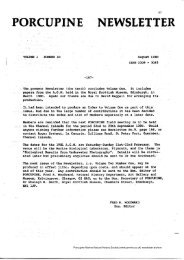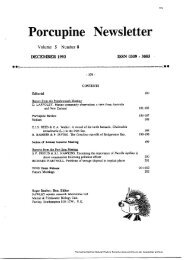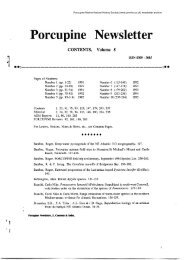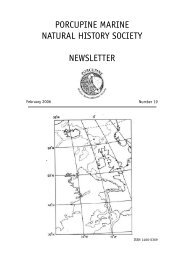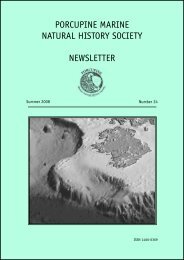Porcupine Newsletter Number 25, Winter 2008/09.
Porcupine Newsletter Number 25, Winter 2008/09.
Porcupine Newsletter Number 25, Winter 2008/09.
Create successful ePaper yourself
Turn your PDF publications into a flip-book with our unique Google optimized e-Paper software.
it grows 4 . The shape of chaetae will thereforedepend on the characteristics of the microvilli.A wave of secretory activity appears to passacross the microvilli. The nature of thewave, its mathematical characteristic, wouldmodulate growth.The polychaete crotchet and uncinusappear to have the same basic shape. Onecan be graphically converted to the otherusing a D’Arcy Thompson transformation(Gibson, 2002). That is, one type can be“morphed”, evolutionarily speaking, into theother by differential growth. This principleprobably applies to all types of chaetae. Theshape of chaetae, then, might, as mentionedabove, conform to a mathematic function(Gibson, Robson & Armitage, 1999). Thisfunction may to some degree be influencedby the environment as in developmentalcanalization, first postulated by Waddington(Calow, 1983).Chaetae grow sequentially and their shapevaries with their age. The form of the crotchetsof Dodecaceria varies within the fascicle of aparapoda, between neuropodia and notopodiaand along the body (Caullery & Mesnil, 1898).This, as noted, is the same for other species.In Arenicola, for example, the rostral teeth ofthe crotches become smaller and can disappear(Ashworth, 1912). Interaction betweenenvironment and gene control may thereforechange with age.Polychaete evolutionPolychaetes are best understood as anad hoc group. That is, their evolution is notclearly monophyletic with one group givingrise to another 5 . The structure of their chaetae,for example, is best seen in terms of functionrather than phylogeny. Dales based hisclassification on feeding structures (1963).Rouse & Pleijel (2001) were equivocal overmorphological evidence for a monophyleticorigin. Polychaetes could have polyphyleticorigin if they had a Precambrian planktonicorigin (Gibson, in preparation). Speciationcould have occurred within the planktonand species dispersed globally in surfacewaters. This might account for the apparentbipolar distributions of D. fimbriata and D.berkeleyi 6 . Planktonic dispersal obviates theneed to postulate continual drift. However,this origin supposes evolutionary stasis (orthat exactly the same changes have occurredin both species).NomenclatureThe distribution and naming of Dodecaceriafimbriata/D. berkeleyi and D. diceria/ D. laddihighlights a weakness in classical taxonomy.The use of priority in naming species has ledto confusion (Gibson & Heppell, 1995; Heppell& Gibson, 1995). The problem is not solved bycompelling authors to follow prescribed codesformulated by bodies such as the InternationalCommission on Zoological Nomenclature. Theseprocedures fail because they stultify taxonomy(Heppell, 1991). Systems must be flexibleenough to allow for changes in approach.Because morphological taxonomy dependson judgement it lacks rigor. This is particularlytrue for Dodecaceria where the species aremorphologically so similar. Computer imageanalysis of the shape of chaetae, a moreobjective method, was used in an attempt toseparate species in this genus (Gibson, Robson& Armitage, 1999; Gibson & Stoddart, 2005).Because the reproduction of the species ofDodecaceria is so varied another approach tothe taxonomy was to use differences in theirreproductive biology (Gibson, 1978). Othermethods that might help in separating speciescould be the use of ontology and ecology. Barcoding (Heppell, 1991) and DNA finger printingmight be effectively used in naming species.SummaryDodecaceria fimbriata and D. berkeleyi havea bipolar distribution even though they appearto be the same species. Continental drift canbe used to account for their distribution. Analternative explanation is that the ancestorsto polychaetes evolved in the Precambrianplankton and were distributed within surfacewaters. There is also the possibility ofconvergent evolution due to similarities inhabitats. However, the environment mayalso have a direct effect on chaetal structurethrough developmental canalization.Dodecaceria diceria and D. laddi arealso morphologically very similar. Theirdistributions although different may on furtherPMNHS <strong>Newsletter</strong> No.<strong>25</strong> <strong>Winter</strong> <strong>2008</strong>/0915




